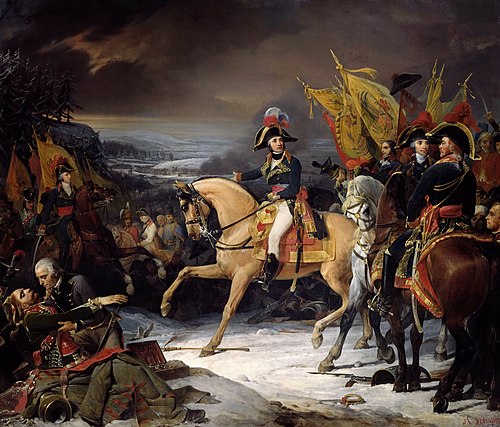
The Salon of 1836 was an art exhibition held at the Louvre in Paris. Since 1833 the Salon had been held annually, featuring paintings, sculptures and other works of art. It was followed by the Salon of 1837.
Contents
It took place during the July Monarchy and featured works depicting the July Revolution of 1830 The Arrival of the Duke of Orleans at the Hôtel de Ville by Charles-Philippe Larivière and The King Distributing Battalion Standards to the National Guard . [1] [2] Louis Philippe I had ordered the restoration of the historic Palace of Versailles as a Musée de l'Histoire de France. This meant commissioning of a number of battle scenes depicting patriotic moments from French history. Notably, Horace Vernet exhibited three paintings ( The Battle of Friedland , The Battle of Jena and The Battle of Wagram ) showing scenes from the Napoleonic Wars intended to hang in the Galerie des Batailles. [3] Vernet also submitted his The Battle of Fontenoy set during the War of the Austrian Succession. In addition works by other artists destined for Versailles were also displayed, including The Battle of Hohenlinden by Henri Frédéric Schopin, [4] The Battle of Marignan by Alexandre-Évariste Fragonard [5] and The Battle of Lauffeld by Auguste Couder. [6] Joseph Beaume's Napoleon's Departure from Elba was intended to be displayed by was withdrawn due to the sensitives arising from Louis Napoleon's failed Strasbourg Coup attempt. [7]
Camille Roqueplan displayed The Lion in Love , now in the Wallace Collection [8] Léon Cogniet's The National Guard of Paris Departs for the Army portrayed a scene from 1792 during the first French Revolution. Eugène Delacroix exhibited The Martyrdom of Saint Sebastian but a painting featuring Hamlet was rejected by the committee. [9] [10] The German artist Franz Xaver Winterhalter made his Salon debut with Il Dolce far niente. [11] The young artist Théodore Chassériau received third-place medal in the category of history painting. [12] A young British artist Thomas Jones Barker also appeared for the first time. When one of Théodore Rousseau's paintings was rejected by the jury, he refused to enter the salon again until the Salon of 1849. [13]
In portraiture Auguste de Châtillon submitted a portrait of the writer Victor Hugo seated with his son. [14] The admiral Henri de Rigny, co-victor at the Battle of Navarino, was depicted by François-Gabriel Lépaulle. Pierre Daubigny produced a miniature featuring the writer Alfred de Vigny. The engraver Jean-Pierre-Marie Jazet exhibited six prints including versions of works by Vernet. [15]























